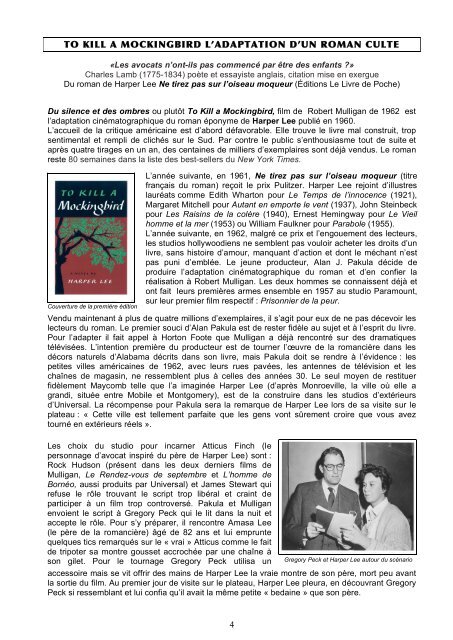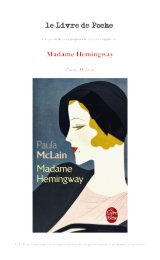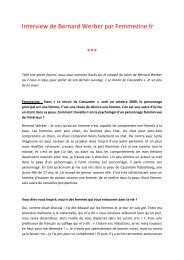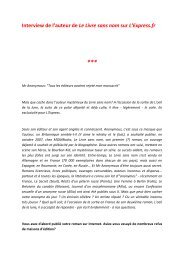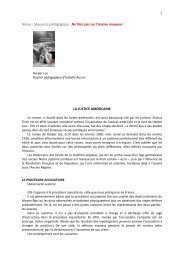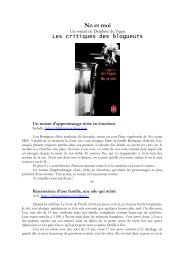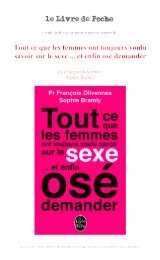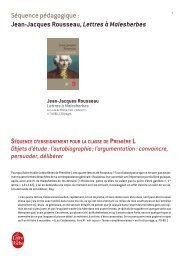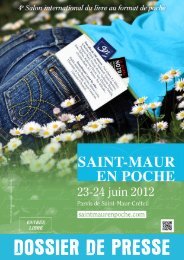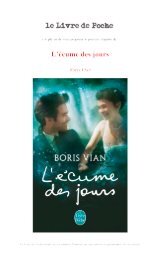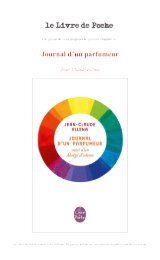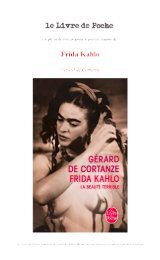le dossier de presse - Le Livre de Poche
le dossier de presse - Le Livre de Poche
le dossier de presse - Le Livre de Poche
- No tags were found...
You also want an ePaper? Increase the reach of your titles
YUMPU automatically turns print PDFs into web optimized ePapers that Google loves.
TO KILL A MOCKINGBIRD L’ADAPTATION D’UN ROMAN CULTE«<strong>Le</strong>s avocats n’ont-ils pas commencé par être <strong>de</strong>s enfants ?»Char<strong>le</strong>s Lamb (1775-1834) poète et essayiste anglais, citation mise en exergueDu roman <strong>de</strong> Harper <strong>Le</strong>e Ne tirez pas sur l’oiseau moqueur (Éditions <strong>Le</strong> <strong>Livre</strong> <strong>de</strong> <strong>Poche</strong>)Du si<strong>le</strong>nce et <strong>de</strong>s ombres ou plutôt To Kill a Mockingbird, film <strong>de</strong> Robert Mulligan <strong>de</strong> 1962 estl’adaptation cinématographique du roman éponyme <strong>de</strong> Harper <strong>Le</strong>e publié en 1960.L’accueil <strong>de</strong> la critique américaine est d’abord défavorab<strong>le</strong>. El<strong>le</strong> trouve <strong>le</strong> livre mal construit, tropsentimental et rempli <strong>de</strong> clichés sur <strong>le</strong> Sud. Par contre <strong>le</strong> public s’enthousiasme tout <strong>de</strong> suite etaprès quatre tirages en un an, <strong>de</strong>s centaines <strong>de</strong> milliers d’exemplaires sont déjà vendus. <strong>Le</strong> romanreste 80 semaines dans la liste <strong>de</strong>s best-sel<strong>le</strong>rs du New York Times.Couverture <strong>de</strong> la première éditionL’année suivante, en 1961, Ne tirez pas sur l’oiseau moqueur (titrefrançais du roman) reçoit <strong>le</strong> prix Pulitzer. Harper <strong>Le</strong>e rejoint d’illustreslauréats comme Edith Wharton pour <strong>Le</strong> Temps <strong>de</strong> l’innocence (1921),Margaret Mitchell pour Autant en emporte <strong>le</strong> vent (1937), John Steinbeckpour <strong>Le</strong>s Raisins <strong>de</strong> la colère (1940), Ernest Hemingway pour <strong>Le</strong> Vieilhomme et la mer (1953) ou William Faulkner pour Parabo<strong>le</strong> (1955).L’année suivante, en 1962, malgré ce prix et l’engouement <strong>de</strong>s <strong>le</strong>cteurs,<strong>le</strong>s studios hollywoodiens ne semb<strong>le</strong>nt pas vouloir acheter <strong>le</strong>s droits d’unlivre, sans histoire d’amour, manquant d’action et dont <strong>le</strong> méchant n’estpas puni d’emblée. <strong>Le</strong> jeune producteur, Alan J. Pakula déci<strong>de</strong> <strong>de</strong>produire l’adaptation cinématographique du roman et d’en confier laréalisation à Robert Mulligan. <strong>Le</strong>s <strong>de</strong>ux hommes se connaissent déjà etont fait <strong>le</strong>urs premières armes ensemb<strong>le</strong> en 1957 au studio Paramount,sur <strong>le</strong>ur premier film respectif : Prisonnier <strong>de</strong> la peur.Vendu maintenant à plus <strong>de</strong> quatre millions d’exemplaires, il s’agit pour eux <strong>de</strong> ne pas décevoir <strong>le</strong>s<strong>le</strong>cteurs du roman. <strong>Le</strong> premier souci d’Alan Pakula est <strong>de</strong> rester fidè<strong>le</strong> au sujet et à l’esprit du livre.Pour l’adapter il fait appel à Horton Foote que Mulligan a déjà rencontré sur <strong>de</strong>s dramatiquestélévisées. L’intention première du producteur est <strong>de</strong> tourner l’œuvre <strong>de</strong> la romancière dans <strong>le</strong>sdécors naturels d’Alabama décrits dans son livre, mais Pakula doit se rendre à l’évi<strong>de</strong>nce : <strong>le</strong>spetites vil<strong>le</strong>s américaines <strong>de</strong> 1962, avec <strong>le</strong>urs rues pavées, <strong>le</strong>s antennes <strong>de</strong> télévision et <strong>le</strong>schaînes <strong>de</strong> magasin, ne ressemb<strong>le</strong>nt plus à cel<strong>le</strong>s <strong>de</strong>s années 30. <strong>Le</strong> seul moyen <strong>de</strong> restituerfidè<strong>le</strong>ment Maycomb tel<strong>le</strong> que l’a imaginée Harper <strong>Le</strong>e (d’après Monroevil<strong>le</strong>, la vil<strong>le</strong> où el<strong>le</strong> agrandi, située entre Mobi<strong>le</strong> et Montgomery), est <strong>de</strong> la construire dans <strong>le</strong>s studios d’extérieursd’Universal. La récompense pour Pakula sera la remarque <strong>de</strong> Harper <strong>Le</strong>e lors <strong>de</strong> sa visite sur <strong>le</strong>plateau : « Cette vil<strong>le</strong> est tel<strong>le</strong>ment parfaite que <strong>le</strong>s gens vont sûrement croire que vous aveztourné en extérieurs réels ».<strong>Le</strong>s choix du studio pour incarner Atticus Finch (<strong>le</strong>personnage d’avocat inspiré du père <strong>de</strong> Harper <strong>Le</strong>e) sont :Rock Hudson (présent dans <strong>le</strong>s <strong>de</strong>ux <strong>de</strong>rniers films <strong>de</strong>Mulligan, <strong>Le</strong> Ren<strong>de</strong>z-vous <strong>de</strong> septembre et L’homme <strong>de</strong>Bornéo, aussi produits par Universal) et James Stewart quirefuse <strong>le</strong> rô<strong>le</strong> trouvant <strong>le</strong> script trop libéral et craint <strong>de</strong>participer à un film trop controversé. Pakula et Mulliganenvoient <strong>le</strong> script à Gregory Peck qui <strong>le</strong> lit dans la nuit etaccepte <strong>le</strong> rô<strong>le</strong>. Pour s’y préparer, il rencontre Amasa <strong>Le</strong>e(<strong>le</strong> père <strong>de</strong> la romancière) âgé <strong>de</strong> 82 ans et lui empruntequelques tics remarqués sur <strong>le</strong> « vrai » Atticus comme <strong>le</strong> fait<strong>de</strong> tripoter sa montre gousset accrochée par une chaîne àson gi<strong>le</strong>t. Pour <strong>le</strong> tournage Gregory Peck utilisa un Gregory Peck et Harper <strong>Le</strong>e autour du scénarioaccessoiremais se vit offrir <strong>de</strong>s mains <strong>de</strong> Harper <strong>Le</strong>e la vraie montre <strong>de</strong> son père, mort peu avantla sortie du film. Au premier jour <strong>de</strong> visite sur <strong>le</strong> plateau, Harper <strong>Le</strong>e p<strong>le</strong>ura, en découvrant GregoryPeck si ressemblant et lui confia qu’il avait la même petite « bedaine » que son père.4


